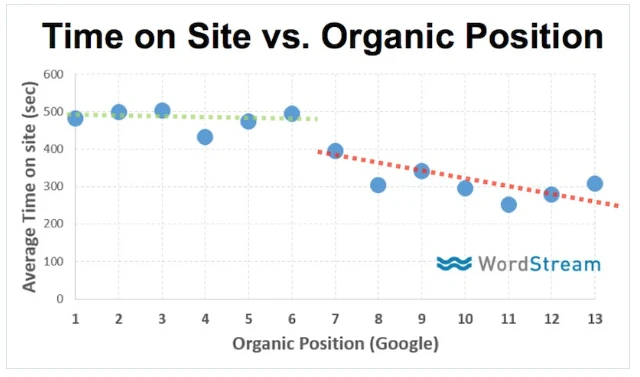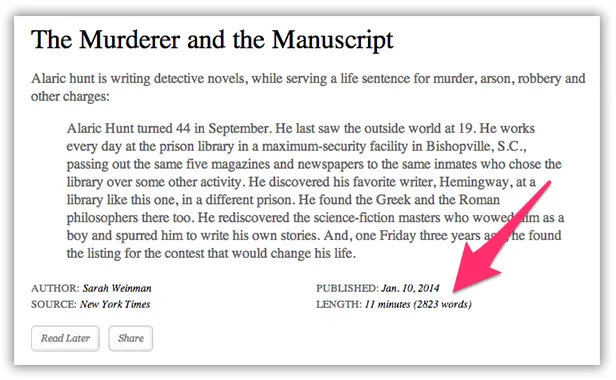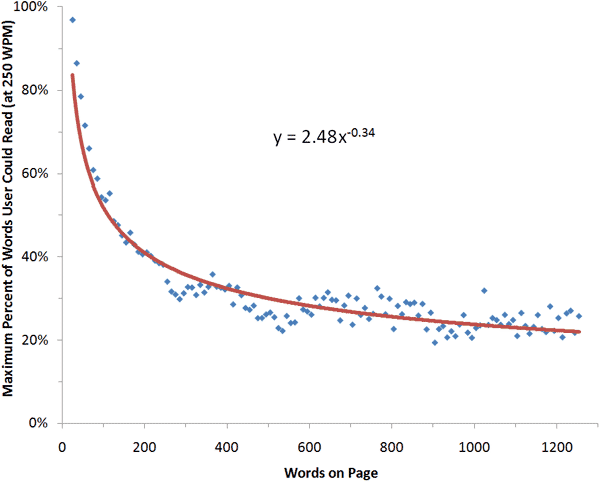Dwell time… you’ve likely heard the term floating around once or twice, but what actually is it? And most importantly, how concerned do you need to be about it?
What is Dwell Time?
The definition for dwell time can often be confused with other metrics, such as average session duration, average time on page and bounce rate. However, dwell time should not be used interchangeably with any of these.
Dwell time is the amount of time a user spends between clicking on a search result and returning to search results.

Dwell time is an excellent indication of the worth of your page to a reader, because the more time they spend on your page, the more useful your content is to them. Pages that have a short dwell time are more likely to be unhelpful to the user. Here is an example of what different dwell times could indicate:
Dwell time vs bounce rate
Many people wrongly confuse dwell time with bounce rate because of a common misunderstanding of what bounce rate really is.
The bounce rate represents the percentage of your site sessions during which a user only looked at one single page.
The bounce rate does not show the percentage of viewers who have left one page and moved on to another one within your site. Rather, it shows the percentage of viewers who have left the website to return to search results after viewing just one page.
It’s worth remembering that a high bounce rate does not necessarily mean that your content was unhelpful. Even if the user has left the page and returned to the search results, they may have done so after spending time absorbing the content (this would be referred to as a ‘soft bounce’). This explains why bounce rate is not the same as dwell time.
Dwell time as a measure helps you to distinguish between hard and soft bounces, and to measure page performance in that percentage of users who bounce.
Dwell time vs average time on page
Google cannot measure how much time a reader spent on the last page they visited on your site. It can only measure the amount of time spent on a page if the next page they access is another one on your site. This means that when a reader accesses just one page and then leaves, the visit is labelled as a ‘bounce’, and the ‘time on page’ is registered as ‘0’ even if they have spent some time reading your content.
Another point to consider is that average time on page is measured regardless of how a user has accessed a page. This could be via a search engine results page, or it could be via a link on social media, or through an email containing a link. Because dwell time is a metric relating only to a user’s search engine-to-site journey, the average page time is not indicative of the same information. This is why average time on page is not the same as dwell time.
Dwell time vs average session duration
Similarly, the average session duration – which measures how long a user has spent on your entire site in one session – does not offer an insight into dwell time.
First of all, dwell time relates only to one page view, rather than an entire website session. The average session duration cannot tell you how long a user has spent on just one page. Secondly, again, the average session duration measures the length of time spent on a site regardless of how the user has arrived there. This means whether they accessed the site via Google, social media, an email, or any message containing a link.
Because dwell time only relates to viewers arriving to one page, from a search engine results page, the average session duration information is not applicable.
How to measure dwell time
The time on page metric is useful in revealing how helpful your page was to those who then clicked on an internal link to another page. Was it a quick-stop means to an end, or was the page truly beneficial for the user that encouraged them on to the next step in their journey? The time spent on page is basically the same as dwell time, only for viewers who did not bounce. This makes time spent on page a practical measure for obtaining a good indication of dwell time for most people.
The bounce rate is a useful metric for determining the worth of the page if your intent was to encourage a reader to access another part of your site. The identification of high bounce rates will indicate where improvement is required, perhaps in the form of more links or a call to action that suggests another page.
The two metrics report on entirely different kinds of users, and therefore one does not impact the other. However, combined, these two metrics go some way toward helping you assess the dwell time of a page.
At the time of writing, we don’t know exactly how Google measures dwell time, but it stands to reason that time on page, bounce rate, and possibly session duration are considered. To measure the dwell time of your content, the only method available right now is to analyse the information you have.
If you want to go one step further and obtain a ‘real’ dwell time metric in Google Analytics, take a look at analytics advisor Luca Tagliaferro’s advice.
Why is dwell time important?
Dwell time should be a primary concern for marketers, and indeed business owners, because, when measured properly, it reflects the true value of your page to a reader when arriving from the search results. Pages that have a high dwell time are clearly offering readers information that they want to read. They offer quality content.
Quality content is necessary in order to encourage viewers to return to your site, as well as to attract new users. Quality content will increase:
- Brand awareness – if your company name is regularly associated with helpful information, your brand will become more well-known in the relevant area.
- Subject authority – by providing good quality content, you demonstrate that your company has knowledge and expertise in the subject you’re talking about.
- Trust in your site – the better the content you have to offer, the more likely readers will be to trust your website and its offering, Poor quality, spammy content is known to put readers off websites altogether.
- More conversions – by supplying helpful information in the form of content, viewers are encouraged to explore your site further – including product pages. This will often lead to an increase in conversions.
The term ‘dwell time’ was first coined in 2011, by Duane Forrester at Bing. He noted that “short page dwell times can indicate the content is not capturing the visitor’s interest”. Without quality content that does capture interest, your website is unlikely to perform well.
But, it’s not only website performance that dwell time relates to. It’s the overall impression of your company’s online presence to your audience. What matters to search engines is also what matters to readers.
Is Dwell Time an SEO ranking factor?
Google has never officially declared that dwell time is a ranking factor. However, Head of Google Brain Nick Frost did allude to that fact that it might be, at a conference in 2017;

Until Google clarifies the situation further – if they ever do – we think that dwell time should be considered an important ranking factor. This is because good content = happy readers = improved SEO. Everything your readers want generally tallies up with what search engines are ultimately looking for – the content that people want to see.
What search engines want
Google constantly updates it algorithms to ensure it continues to serve the best possible results to users’ queries. Search engines are constantly monitoring how users interact with your website in order to determine its value to those users. Therefore, a site that regularly does not engage its readers will likely be considered less helpful than another website, where readers have a longer dwell time. Looking at the correlation between time on site and organic position, it’s clear that websites that keep a reader’s attention for longer are awarded a higher position:

Source: https://moz.com/blog/do-website-engagement-rates-impact-organic-rankings
How to improve dwell time
The idea of improving dwell time is to make readers want to stay on your page for longer, to take in all the information that you’re providing. There is a range of different ways to do this.
1. Capture a reader’s attention from the start
The first consideration when writing a piece designed to capture a reader’s attention is to start off well. That means including a snappy, memorable title, that immediately provokes an interest and encourages the viewer to read the next section – the introduction.
The introduction should be clear and thought-provoking. It should offer a brief insight into what the rest of the content will address, reconfirming the idea that questions will be answered. To do this, be sure to incorporate the relevant keywords in a natural way. Make it clear that there’s a reason why the reader arrived at your page, and that there is a good reason for them to stay.
2. Maintain the reader’s interest using layout
It’s important to remember that a significant proportion of viewers will not read all the content on a page. In fact, research carried out by Chartbeat in 2017 revealed that 55% of viewers will lose interest in a page after just 15 seconds.
55% of readers will leave a site having engaged w/ content for less than 15 sec. Tips for building a loyal audience: https://t.co/pOnTWoVxi2
— Chartbeat (@Chartbeat) May 31, 2017
There are a number of things content marketers can do to combat this problem, simply by improving the page’s layout. To make long-form content more interesting, be sure to include as many of the following as is deemed genuinely helpful:
- Videos
- Images
- Infographics
- Tables and graphs
- Motion graphics
- Screenshots
By incorporating these features, you avoid putting readers off with huge walls of text that look intimidating and possibly even dull!
3. Improve the readability of the text
In addition to creating a reader-friendly layout, consider the different ways you can make sure what text you do have is easy to digest. Some ideas include:
- Short sentences
- Short paragraphs
- Simple language – avoid jargon
- Bullet points
- Bold text Short sentences
- Short paragraphs
There is an art to achieving a balance between authority and accessibility, which largely depends on the audience you want to attract. For instance, a layman may prefer simpler language and short sentences, whereas an expert could be put off by these choices, assuming that the author is not an authority on the subject.
4. Ensure your content is genuinely useful
As well as analysing the presentation of your information, it’s vital to consider the true value of the text itself. Be brutal when answering the following:
- Are you answering questions that readers are asking?
- Have these questions already been answered better by someone else?
- If yes to the above, is there anything you can add to make your content stand out?
- Is every section of the content necessary and helpful? If not, take it out or improve it.
If your content is similar or worse than what’s already online, there’s no point in publishing it. Think about what you’re really offering a reader – do you genuinely believe your content is worth their time?
To help make sure you’re answering the questions that people are really asking, do thorough competitor and keyword research.
5. Offer something extra to the reader
Think about whether there is anything extra that you can add to your content that will benefit the reader. To determine this, ask yourself whether a reader would want to share information from the piece, if they’d have practical take-aways to apply to their work, or if it might be something they would bookmark to refer to again at a later date.
‘Something extra’ could be something that they didn’t even know they were looking for, such as complimentary information or useful statistics. Ideas for things to include would be a closely-related asset, such as a how-to video, or a carousel of images designed to inspire.
Internal links are another addition that can be beneficial to the reader, as well as to the site as a whole. If you can include relevant links that guide the reader to further, helpful information, this is likely to be valuable to them. These also have the added benefit of encouraging the reader to stay on your site, thereby improving your bounce rate.
6. Avoid encouraging readers to leave your site
Even content writers with the best intentions can inadvertently encourage readers to leave their page. This most often happens when assets, such as videos or motion graphics that are hosted elsewhere, are embedded into the copy. These require people to leave the page to watch them. Similarly, links to sources or external supplementary information can cause people to leave the site unless ‘no-follow’ HTML has been used.
7. Inform readers of the length of copy
Another tool that many content marketers have found useful is to declare at the start of the content, the length of time it will take to read it. There is evidence to suggest that the psychology behind supplying this information encourages a reader to keep going.

Source: https://marketingland.com/estimated-reading-times-increase-engagement-79830
It’s also worth noting that while there is evidence to show that long-form copy is beneficial for SEO, it does not necessarily impact on dwell time. The fact that readers often have short attention spans might mean they don’t make it to the end of your page, but nevertheless, they may be more likely to find your page, as it sits higher in the search engine results pages.
8. Optimise your site speed
A common reason why users abandon web pages is that they do not load fast enough. These days attention spans are lower and there is ample choice when it comes to content. This means that readers are likely to be able to find what they’re looking for elsewhere, instead of waiting for your site to load. It’s never been more important to make sure your website is fast and responsive.
Conduct testing to check load times of pages – on desktops, tablets, and mobiles – to find out if this could be impacting on your dwell time.
What is a good dwell time?
After acknowledging that improving dwell time should be a priority, the next step is to determine exactly what you’re aiming for. When he first explained what is meant by the term ‘dwell time’, Duane Forrester at Bing also wrote:
“A minute or two is good as it can easily indicate the visitor consumed your content. Less than a couple of seconds can be viewed as a poor result. And while that’s not the only factor we review when helping to determine quality, it’s a signal we watch.” (source)
Obviously, the longer the time a user stays on your page the better, but this is likely to differ depending on what’s on the page. If you know your page should take around 11 minutes to read, consider aiming for a certain percentage of this. On the other hand, if you have a short page that contains infographics and minimal text, the time it takes to consume the content will be much lower. You should perhaps only expect a minute or two in this case. The NN/g Nielsen Norman Group has carried out research to determine the ‘maximum amount of text users could read during an average visit to pages with different word counts’;

This reveals that averagely, even when pages contain around 100 words, only half of these are being read.
Thinking about dwell time should form part of your larger content marketing plan. If it’s not, or you need some assistance in curating the perfect strategy, get in touch with the SEO experts at MRS Digital. Learn more about our professional SEO services and how we could help your business.






